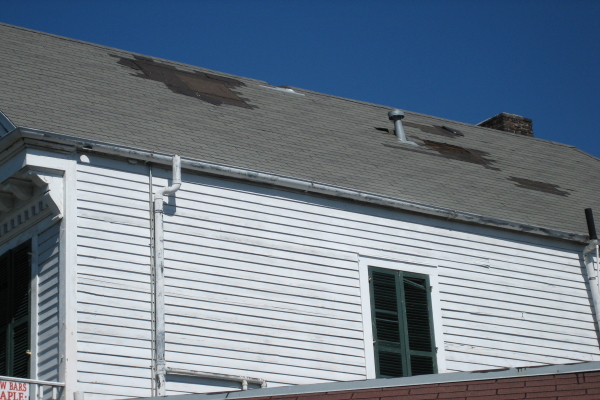
When the weather gets chilly after summer's warmth, you can expect the instability to cause hurricanes and cyclones. Unfortunately, in South Windsor CT, these sometimes evolve into strong-winded rainstorms that can uproot roofing material and afterwards require intensive roof wind damage repair.
The repair procedure for roof wind damage is similar to any and all existing processes. However, as any experienced and knowledgeable South Windsor CT roofing contractor knows, identifying the full details of the roof's condition is the key to proper roof wind damage repair. Dry Home has an excellent list of areas to inspect below.
Perform an Outdoor Inspection
Look for missing and damaged shingles (damaged shingles might be curled, cracked, or torn) on your roof or around your property. If this type of damage is localized (i.e., it covers less than 30 percent of the entire roof), roofing repairs might be able to address the problem. More extensive damage might necessitate roof replacement. Also keep in mind that not only the roof itself, but the chimney, ventilation pipes, roof flashing, gutters and fencing can also become damaged. Be sure to inspect them for damage as well. If you suspect that your roof is damaged, here is a basic list of what to look for:
- Composition shingles: curling, loss of granulation, broken, damaged or missing shingles
- Wood shingles/shakes: Mold or decay, splitting or curling
- Flat roof: Obvious patches, cracks or tears, several blisters and/or wrinkles (also check patched areas from inside the attic)
- Flashing: Tears, buckling around roof penetrations
- Roofing cement: Excess cement, crumbling
- Soffits and fascia: Decay, stains
- Soffit and ridge vents: Clogged or damaged vents, flashing and shingles around them curling or missing
- Gutters: Decay or rust, leaky seams, loosely attached to structure, bent or sagging, missing sections of gutter or downspout, filled with debris. Clogged gutters can easily freeze shut and cause excessive weight on gutter fasteners, ice dam conditions, and slippery walks below.
- Chimneys: Leaning, loose or missing flashing, damaged bricks, cap or cracked joints. Chimney flashing is especially prone to tearing because a chimney settles independently from the house. (Continued)
Prevention is always better than any cure, and it's less expensive too. Preventative measures to reduce or even eliminate material uprooting and eventual roof wind damage repair exist. However, it begins right at the start -- the moment your architect designs your roof and the roofing contractor installs it in place.
Roof design plays an integral role in preventing strong winds from blowing off a roof. Fortunately, the roof design doesn't have to make your roof installation expensive to resist strong winds. LSU AG Center has a good list of roof design characteristics that can resist strong winds.
Roof Wind Damage Repair Prevention: Design considerations
Hip roof style: Hip roofs (four-sided roof design) are more aerodynamic and inherently more resistant to uplift forces of high wind than gable end and other roof designs. Gable end walls braced: If your home has a gable roof (two-sided pitched roof), the end wall takes a beating during a hurricane, and typical framing methods create a vulnerable “hinge” line at the joint between levels. If not properly braced, it can collapse. Properly bracing gable end walls can prevent wind from pushing or pulling the gable end at that weak point.In new construction, this can be provided with code-specified bracing details – which may include lateral bracing and blocking of ceiling joists, extra metal strapping, structural panels under the joists and sometimes cross bracing of ceiling to roof framing.
A simpler alternative to bracing is to use a “balloon framing” method for gable end walls; this refers to using continuous studs or columns from the foundation to the roof without a break. This method is less labor intensive, but tall spans may need larger lumber or closer spacing than for other walls. (Continued)
However, the roof design is only 50% of the preventative measures you can take to prevent roof wind damage repair. Using the right materials allow you to clamp down your roof deck with their weight and density.
Luckily, these roofing materials are available from any supplier, and they're not too expensive. Traditional asphalt shingle roofing is one of the best wind-resistant materials to prevent costly roof wind damage repair. Goodrich Roofing has a list of the best materials below.
Roofing Materials Resistant to Roof Wind Damage
Asphalt Shingles
The most common type of residential roofing in the country, asphalt shingles are used in over 90% of U.S. homes. Available in different styles and colors, these roofing materials are tested to perform well against fires and storms. In fact, the standard types can handle 60- to 80-mile-per-hour wind speeds while architectural shingles can withstand winds of up to 110 miles per hour.
Metal
This roofing material offers better resistance to wind damage, minimal upkeep and longer lifespans. It can perform well in any weather, regardless of severity. Installation requirements call for fewer sheets, which reduces the likelihood of wind passing through openings within the roofing system. (Continued)
Remember, preventative measures that avoid costly roof wind damage repair require the use of an experienced and knowledgeable roofing professional. If you have yet to find a reliable roofer, you can count on Slavin Home Improvements to help. With over 10 years of roofing experience and serving residential properties across South Windsor CT, we're confident in delivering what you need. Allow our team to help -- call us today!